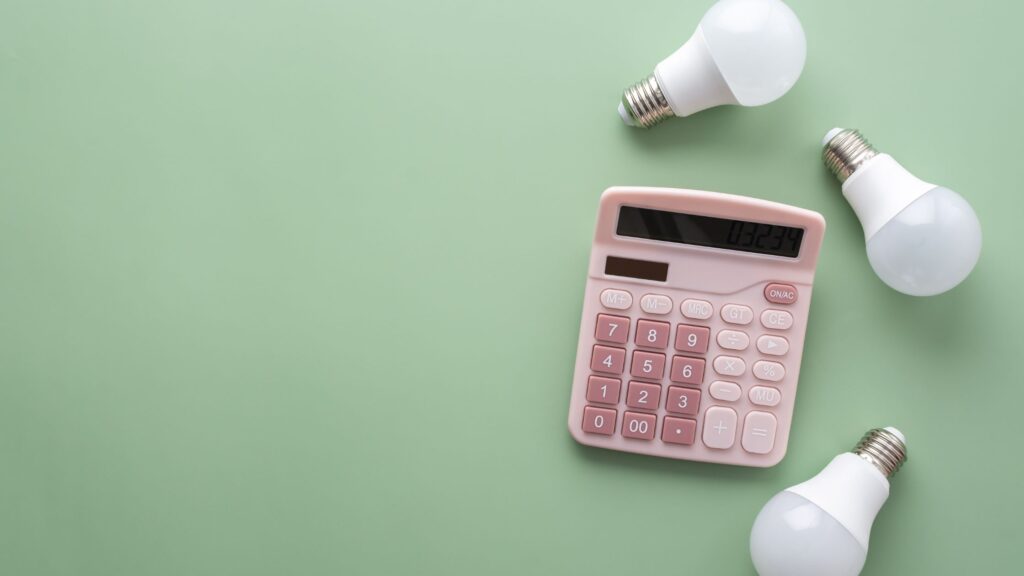Learning how to save on utility bills doesn’t mean sacrificing comfort. Simple swaps like smart thermostats, better insulation, and water-wise habits can cut costs fast while keeping your home cozy and efficient.
Every time I open my utility bill, I swear it sighs before I do. If you’ve been hanging out with me for a while, you already know we’ve talked about grocery spending and budget-friendly seasonal swaps. But learning how to save on utility bills hits a little closer to home — literally.
It’s all part of that “live well for less” lifestyle I keep talking about.
Saving money doesn’t mean shivering through winter or showering in the dark, I promise. So fill your favorite coffee mug, get comfy, and let’s chat about a few easy, real-life ways to keep your home cozy and your wallet happy.
Disclaimer: This article contains affiliate links. I earn from qualifying purchases through these links at no additional cost to you.
Disclosure: I’m not a financial expert or a health professional. I don’t have a degree in finance, math, economics, or medicine. I’m just a gal who’s been there before. If you need professional advice, I recommend consulting an expert.
Embrace the Power of Smart Technology
I used to roll my eyes at “smart” gadgets. They were just one more thing to set up and forget about. Or worse… one more thing to turn me into a full-on cyborg. “Assimilate….resistance is futile.” Don’t laugh. It could totally happen.
At least in the case of smart thermostats, I was wrong. I don’t have a smart thermostat myself, but I know a few people who do, and they absolutely swear by it. The thing adjusts the temperature automatically when they’re not home. Kind of like your kids (or your husband) automatically adjusting the items in your shopping cart when you’re not looking. At least for these thermostats, the change is a positive one.
The savings for these gadgets are impressive. They can cut heating and cooling costs by roughly 10% a year. That’s like snagging a free month of energy. The best part is you don’t have to think about it. (I’ve got some laundry I don’t want to think about. Now all I need is someone to come up with a smart laundry maid that finds, washes, dries, folds, and puts away the clothes — not a real maid, but a machine I can pay for once. ‘Rosie,’ from The Jetsons, would do just fine.
Many utility companies offer rebates for smart devices like thermostats and lighting. It’s literally getting rewarded for living frugally. Win-win. If you’re trying to figure out how to save on utility bills without major lifestyle changes, smart tech is one of the easiest places to start. And you can check with your utility company to determine what energy-saving smart technology programs are available in your area.
Smart Plugs and Lighting
- Smart Plugs: These are perfect for those “Did I unplug the iron?” panic moments. You can shut off appliances from your phone, even when you’re out.
- LED Lights: Replacing traditional bulbs with LEDs can cut lighting costs by as much as 90% and last up to 25 times longer than incandescent ones, according to ENERGY STAR. That means fewer replacements, lower bills, and a brighter home.
- Energy Monitoring Apps: I’m obsessed with checking what’s secretly eating our electricity. Apps like Sense Energy Monitor show exactly which devices are power hogs in real time.

Water Wisely
You know how we’ve talked about wasting groceries is like tossing money straight into the trash? Water’s no different. It slips away a few drops at a time. Before you know it, the cost adds up. My landlady covers the water bill at my place. Still, I do my part to keep usage low. It feels right. Better for the planet, the pipes, and my conscience.
If you pay for water, those small habits matter. The savings sneak up faster than you’d think. So, let’s talk about a few simple ways to use less without feeling deprived.
Low-Flow Fixtures and Habits
- Install Low-Flow Fixtures: I swapped out my showerhead last year and barely noticed the difference. These fixtures can cut water use by up to 60%. Bonus: some, like mine, have a fantastic massage spray that’s perfect for sore muscles!
- Change Small Habits: I started timing my showers (don’t laugh), and EPA WaterSense notes that habit tweaks like that can save about 200 gallons a month. So, here’s to quick ‘power showers’ that still hit all the right notes.
- Fix Leaks Fast: One tiny drip can waste more than 3,000 gallons a year. Even if I’m not footing the bill, I still fix leaks fast, because waste is waste, no matter who pays.
If you’ve got a garden like me, look into an Orbit irrigation controller. It’s a smart sprinkler controller that automatically adjusts watering schedules based on your weather and soil conditions. That means no guessing and no wasted water.
If you're curious about the Orbit irrigation controller, here's a quick rundown in plain English:
- Saves you time: It waters for you so that you can focus on anything but dragging hoses.
- Flexible setup: Works indoors or outdoors, wherever it makes sense for your setup.
- Set it and forget it: Drip irrigation that keeps plants happy without the guesswork.
- Smart adjustments: Adapts automatically to weather, saving both water and money.
- Easy control: Manage it from your phone, whether you're home or away.
The EPA WaterSense certification proves it uses about 20% less water than standard systems. That’s real savings for your wallet and the planet. Learning how to save on utility bills often starts by reducing water waste. It’s one of the easiest and most practical ways to make a measurable difference.
Be an Insulation Aficionado
This one hits home hard for me. I live in an older mobile home, and it’s pretty drafty during winter. So, I’m doing what I can to seal things up, keep us warmer, and save on heating costs.
You’d be surprised how fast you lose heat during winter. Heat escapes from your house faster than my Monday motivation, especially if your insulation’s not up to par or you live in an older home. I didn’t realize how much I was losing until I sealed a few gaps and felt a noticeable difference. A little effort went a long way. So, if you’re ready to cozy up and keep your cash where it belongs, here’s where to start.
DIY Insulation Tips
- Seal Gaps and Cracks: Grab a cheap tube of caulk and weatherstrip doors and windows. It takes an hour, but it pays off every month.
- Upgrade Attic and Wall Insulation: Properly insulated attics and walls can reduce energy use by up to 20%. That’s serious savings for one weekend project, if you own your own home.
- Insulate Windows: My place is drafty, so I use heavy-duty plastic sheeting on the inside and outside instead of a traditional window kit. It’s not fancy, but it makes a noticeable difference in keeping the cold air out and the warm air in.
- Seal External Door Gaps: A simple draft stopper or weatherstripping around exterior doors can keep cold air from sneaking in under the door. I use one of those weighted door snakes during the coldest months — it’s inexpensive and works surprisingly well.
- Sliding Glass Doors: If you’ve got a slider, line the edges with foam insulation tape and hang a thick curtain or thermal panel over it. It keeps the room warmer and adds a cozy vibe.
- Floor Draft Barriers: In older homes or mobile homes, floors get cold fast. A simple area rug or layered mat, especially near exterior doors, helps lock in warmth and adds comfort underfoot.
Improving insulation might not sound exciting, but it’s one of the smartest ways to reduce energy costs. During winter, when heating bills soar, a well-insulated home retains heat longer.
Minor upgrades can make a big difference. Even a weekend project can help your home feel cozier, quieter, and a lot more efficient.

Energy Audit: The Secret Weapon
Never had an energy audit before? Think of it as a health checkup for your house. A professional will spot where your money’s leaking out… literally. Many utility companies provide free or low-cost audits, and they’ll even tell you which upgrades pay off fastest.
Professional vs. DIY Audits
You can go the professional route with infrared imaging and blower door tests. Or keep it simple and do your own version. I started small — checking for drafts, comparing old bills, and noting where things didn’t add up. It’s incredible how much you can spot once you start paying attention. A few quick checks helped me find the significant leaks hiding in plain sight.
Here’s a fun fact worth sharing. The Department of Energy says simple fixes uncovered during an audit can slash annual energy costs by roughly $200–$400. That’s huge if you’re saving for something fun (like your next girls’ weekend getaway). Performing an audit is another key step in learning how to save on utility bills for the long term.
Reader Q&A: Your Utility Bill Questions Answered
Wondering what others ask about cutting energy costs? You’re not alone. These are some of the most common (and relatable) questions I found from frugal readers looking for real, everyday answers to lower their bills without giving up comfort.
Ready to cut your bills (and stress)?
If today’s post got you thinking about where your money’s sneaking off to, take a breath. Start small. Pick one thing from this list and try it this week. Then check back in and tell me how it went. I love hearing about your wins, no matter the size.
Once you start focusing on how to save on utility bills, it becomes a habit. Little by little, those changes stack up faster than you’d expect.
Want even more tips and behind-the-scenes stories about living better for less? Subscribe to Frugal Hen today. You’ll get fresh, practical ideas straight to your inbox. No fluff. No spam. Just innovative, simple ways to live well for less. Let’s keep building a life that feels full.
Image Credit: © pundapanda via Canva.com | © Sindre Fs from Pexels via Canva.com | © NAME via Canva.com
What to Read Next (Because You’re On a Roll)
- How to Save Money on Groceries Without Clipping Coupons
- 11 Genius Money Hacks to Save More Cash
- Smart Ways to Boost Your Emergency Fund Without the Stress






